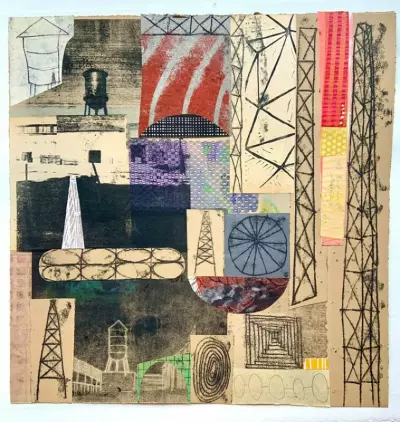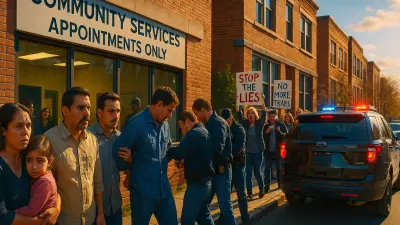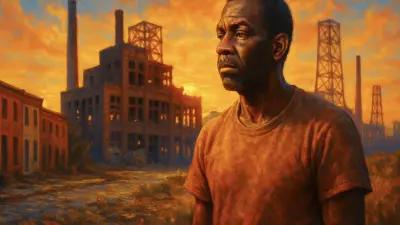This following is an excerpt from an essay by Piiparinen entitled “Made in the USA: The Rust Belt,” part of a collection comprising the book “Octopus Hunting,” published by Red Giant Books in Cleveland.

It was the early 1980s and my old street in Cleveland, Colgate Ave., was becoming a shell of itself.
By then you didn’t have to be well off to join the suburban ranks, barely working class sufficed. We had to stay. My dad was a 2nd District Cleveland cop and there were residency requirements for civil servants. Beyond that, our living arrangements were old school. My dad’s mom and brother lived above us, and my mom’s mom and dad were across the street. But all around us, families left: the Beckwith’s, the Mill’s, the Davies’. Anger and fear threaded the void.
I remember one time as a child, I was standing on the front porch. It was late Summer, dusk. Two White women of Appalachian descent were squaring off in the intersection. Their hands were full of hair. The audience cat-called and moaned. It was a naked display of humanity, an embryonic experience for a child. Looking back, the scene brought into focus of just how what’s big and abstract becomes what’s touchable and characteristic of neighborhood decline which, in turn, gets absorbed into thoughts, feelings, and behaviors of everyday people.
Every day. In academic parlance, this is what social scientists mean when they say individual outcomes, like health and education, are socially determined. Elaborating, so much of what’s put out there is stored in the mind and body of the observer from where it is urged forward into experience and then on into another’s mind and body — making time spent a Jetstream of consequence and dictation.
By 1990, we were gone too. My dad had died. My grandma, his mom, went back to Finland to die. My mom, sister, and I went to the blue-collar suburb of Lakewood. But my mom’s mom stayed.
One day my grandma, a tough-as-nails, second-generation Italian who drove a boat-long Cadillac and smoked white, skinny cigarettes and drank Pepsi out of a 2- liter, was looking out her living room window at our old house across the street.
A man was on the upper front porch, and another was on the lower porch where I once stood watching the women square off. The man higher up shot and killed the man below. Eventually, fists turned to bullets and bruises to death. Emptiness grew. The street became one of phantoms and pieces of fury.
Too many Rust Belt streets are like that. If you don’t know what I’m talking about, get out, poke around a little bit. If you do, then you do.
You could argue the milieu and mood was warranted. Matter of fact, the American Midwest is known for its Opie-like, oh-geez modesty and plain-speak. It’s manners.

But there’s this kernel within the Heartland — the Great Lakes — and there’s a kernel within the Great Lakes — the inner-city Rust Belt — that wasn’t born yesterday. That never even touched a turnip truck. That doesn’t suffer fools and is only as pleasant as you are. That can cuss with the best of those in South Boston or the Bronx.
It’s no surprise, then, that the Rust Belt streets can be steeped in acrimony. Irritation was to be expected. Even hate.
The sons and daughters of the arsenal of democracy were left to fend for themselves after their lineage split sides and busted knuckles to prove worth and fight fascists.
We lionize hard work in America yet dump on the generations of hard workers, setting families up for a pendulum of hard times. America can be so giving and unforgiving. It wasn’t fair. Life isn’t fair.
And what’s arguably the most frustrating part about it is that what’s unjust is not divinely decreed. There is no such thing as a necessary evil. There are only unnecessary evils.
Economic policies and business practices are a bite of the apple. It’s all volitional. It’s all free choice. Rational man? Yeah right. “[Y]ou know, there’s a difference between the textbook world that economists like to imagine, and the real world where real people have real feelings,” said Paul Romer, a Professor of Economics at NYU and former Chief Economist at the World Bank.
I mean, when one of your high priests speaks so openly dismissively about a backbone of the field, maybe it’s time to dress down and stare inquisitively at the curvatures in the mirror and call it like it is. What’s that? It’s something that psychologists — be they behavioral, social, existential, or psychodynamic — have known for some time.
It’s the irrational man that calls the shots. See, for instance, the book from acclaimed economists George Akerlof and Robert Shiller called “Animal Spirits: How Human Psychology Drives the Economy, and Why It Matters for Global Capitalism.” This is one case where you can in fact read the book by its cover. From the overview: “The global financial crisis has made it painfully clear that powerful psychological forces are imperiling the wealth of nations today.”
To that end, the Rust Belt didn’t just happen naturally, like a dead leaf does after falling from a tree. It was manmade and not just the effect of evolutionary market forces.







